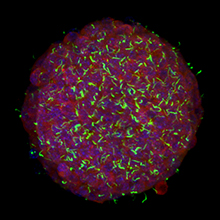

Beta cells in Langerhans island, green:cilia, blue: cell cores, red: insulin. Source: Helmholtz Zentrum München
A research team led by Dr Jantje Gerdes and Professor Per-Olof Berggren now demonstrate that insulin receptors sit on the cilia of beta cells in the pancreas. The cell extensions consequently play an important role in insulin release. In the 'Nature communications' journal, the scientists report that changed ciliary function can be associated with the development of type 2 diabetes.
Scientists at Helmholtz Zentrum München (HMGU), at Karolinska Institutet (KI), Stockholm and the University College London investigated the function of ciliary cell extensions in the pancreas. Stimulation of the insulin-producing beta cells increases the number of insulin receptors on their cilia. The cilia consequently play an important role in the release and signal transduction of insulin, a hormone that reduces sugar levels.
Defective cilia lead to elevated blood sugar levels and lowered insulin release
The lead author of the paper Dr. Jantje Gerdes, formerly at the Rolf Luft Research Center for Diabetes and Endocrinology, KI and now at the Institute of Diabetes and Regeneration Research at the HMGU, found significantly elevated blood sugar levels in animal models when the cilia were genetically reduced or functionally limited. The insulin release in mice with few/defective cilia was also reduced.
“It has been known for some time that the rate of type 2 diabetes is above average in people with ciliopathy, which is a pathological ciliary dysfunction. Our results confirm this observation and additionally explain how cilia are linked to sugar metabolism and diabetes,” explains study leader Gerdes.
The senior author of the paper, Professor Per-Olof Berggren, at KI adds, “Ciliary dysfunction and defective glucose utilization are directly linked. Ciliopathies therefore have a potential function as models in the investigation of many still unknown mechanisms that underlie diabetes.”
Further Information
Original publicationen:
Gerdes, J. et al. (2014). Ciliary dysfunction impairs insulin secretion and promotes development of Type 2 Diabetes in rodents, Nature communications, doi: 10.1038/ncomms6308
The Helmholtz Zentrum München, as the German Research Center for Environmental Health, pursues the objective of developing personalized medicine for the diagnosis, therapy and prevention of wide-spread diseases such as diabetes mellitus and lung diseases. To this end, it investigates the interactions of genetics, environmental factors and lifestyle. The Zentrum's headquarters is located in Neuherberg in the north of Munich. The Helmholtz Zentrum München employs around 2,200 people and is a member of the Helmholtz Association, which has 18 scientific-technical and biological-medical research centres with around 34,000 employees. The Helmholtz Zentrum München is a partner in the Deutsches Zentrum für Diabetesforschung e.V.
The German Zentrum für Diabetesforschung e.V. (German Center for Diabetes Research) brings together experts in the area of diabetes research and combines basic research, epidemiology and clinical applications. The members are the German Diabetes Center in Düsseldorf (DDZ), the German Institute of Human Nutrition Research (DIfE) in Potsdam-Rehbrücke, Helmholtz Zentrum München – German Research Center for Environmental Health, the Paul Langerhans Institutes of Carl Gustav Carus University Hospital Dresden and of Eberhard-Karls-University of Tuebingen, the Science Association Gottfried Wilhelm Leibniz e.V., and the Helmholtz Association of German Research Centres. The objective of the DZD is to find answers to open questions in diabetes research by means of a novel, integrative research approach and to make a significant contribution to improving the prevention, diagnosis and treatment of diabetes mellitus.
The work of the Institute of Diabetes and Regeneration Research (IDR) concentrates on biological and physiological research of the pancreas and the insulin-producing beta cells. The IDR consequently contributes to explaining the development of diabetes and the discovery of new risk genes for the disease. Experts from the fields of stem cell research and metabolic diseases work together on solutions for approaches to regenerative therapy for diabetes. The IDR is a part of the Helmholtz Diabetes Center (HDC).
Scientific contact
Dr. Jantje Gerdes, Helmholtz Zentrum München – German Research Center for Environmental Health (GmbH), Institute of Diabetes and Regeneration Research, Ingolstädter Landstr. 1, 85764 Neuherberg, Germany – Tel.: +49 89-3187-2072 – Email
Contact
Communication Department
Helmholtz Zentrum München –
Deutsches Forschungszentrum für Gesundheit und Umwelt (GmbH)
Ingolstädter Landstraße 1
85764 Neuherberg
Germany
Phone: +49 89 3187-2238












